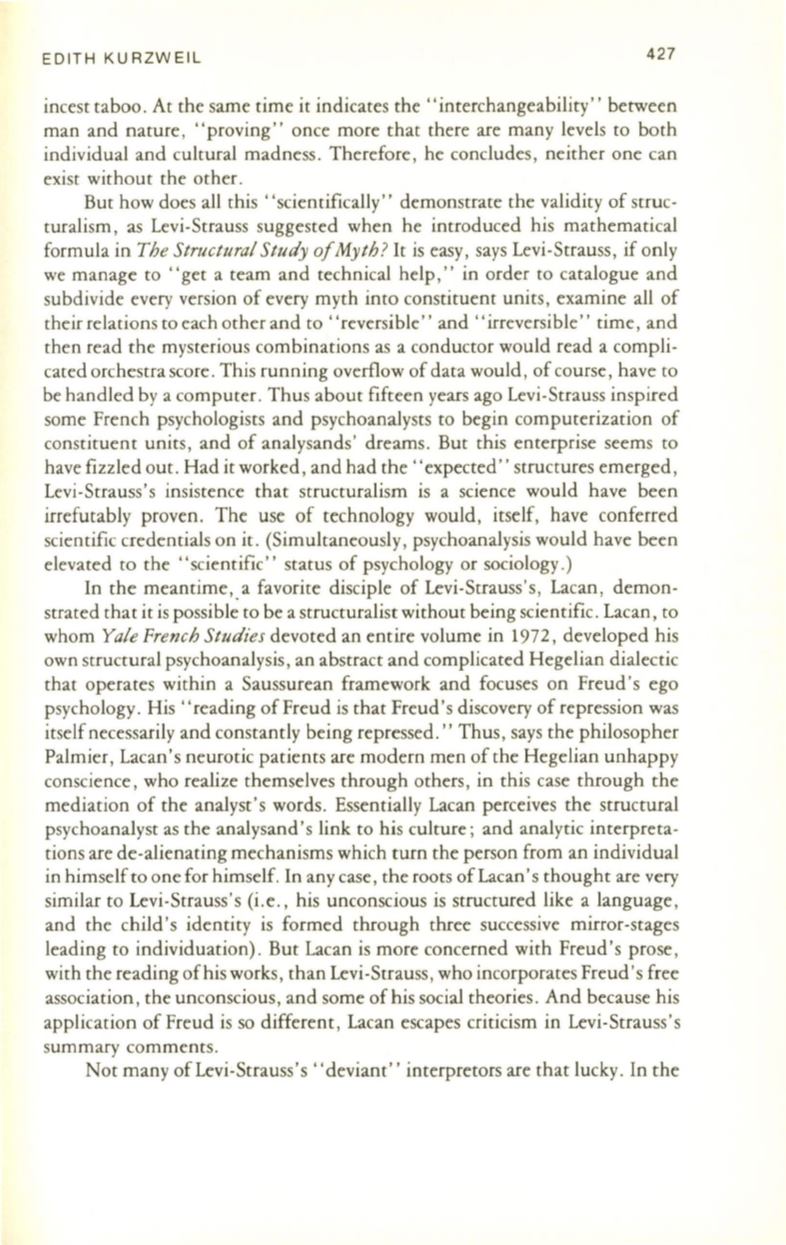
EDITH KURZWEIL
427
incest taboo. At the same time it indicates the" interchangeability" between
man and nature, "proving" once more that there are many levels
to
both
individual and cultural madness . Therefore, he concludes , neither one can
exist without the other.
But how does all this' 'scientifically" demonstrate the validity of struc–
turalism, as Levi-Strauss suggested when he introduced his mathematical
formula in
The Structural Study ofMyth?
It is easy, says Levi-Strauss,
if
only
we manage to "get a team and technical help ," in order
to
catalogue and
subdivide every version of every myth into constituent units, examine all of
their relations to each other and to "reversible" and" irreversible" time, and
then read the mysterious combinations as a conductor would read a compli–
cated orchestra score. This running overflow of data would, of course, have
to
be handled by a computer . Thus about fifteen years ago Levi-Strauss inspired
some French psychologists and psychoanalysts to begin computerization of
constituent units, and of analysands' dreams . But this enterprise seems
to
have fizzled out. Had it worked, and had the" expected" structures emerged,
Levi-Strauss's insistence that structuralism is a science would have been
irrefutably proven. The use of technology would, itself, have conferred
scientific credentials on it. (Simultaneously, psychoanalysis would have been
elevated
to
the "scientific" status of psychology or sociology .)
In the meantime,.a favorite disciple of Levi-Strauss's, Lacan, demon–
strated that it is possible to be a structuralist without being scientific. Lacan,
to
whom
Yale French Studies
devoted an entire volume in 1972, developed his
own structural psychoanalysis, an abstract and complicated Hegelian dialectic
that operates within a Saussurean framework and focuses on Freud's ego
psychology . His" reading of Freud is that Freud's discovery of repression was
itself necessarily and constantly being repressed." Thus, says the philosopher
Palmier, Lacan' s neurotic patients are modern men of the Hegelian unhappy
conscience, who realize themselves through others, in this case through the
mediation of the analyst's words . Essentially Lacan perceives the structural
psychoanalyst as the analysand's link
to
his culture; and analytic interpreta–
tions are de-alienating mechanisms which turn the person from an individual
in himself
to
one for himself. In any case, the roots of Lacan' s thought are very
similar
to
Levi-Strauss's (i.e., his unconscious is structured like a language,
and the child's identity is formed through three successive mirror-stages
leading to individuation). But Lacan is more concerned with Freud's prose,
with the reading of his works, than Levi-Strauss, who incorporates Freud's free
association, the unconscious, and some of his social theories . And because his
application of Freud is so different, Lacan escapes criticism in Levi-Strauss's
summary comments .
Not many of Levi-Strauss's "deviant" interpretors are that lucky. In the


